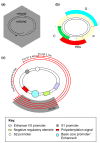Progress in the use of RNA interference as a therapy for chronic hepatitis B virus infection
- PMID: 20429960
- PMCID: PMC2873806
- DOI: 10.1186/gm149
Progress in the use of RNA interference as a therapy for chronic hepatitis B virus infection
Abstract
Chronic infection with hepatitis B virus (HBV) occurs in approximately 6% of the world's population and carriers of the virus are at risk for hepatocellular carcinoma and cirrhosis. Current treatment regimens, which include interferon-alpha and nucleoside/nucleotide analogs, are only partially effective and new treatment methods remain an important objective. Harnessing the RNA interference (RNAi) pathway to achieve post-transcriptional silencing of rogue genetic elements is an exciting avenue for development of novel therapeutic strategies. The specific and potent suppression of HBV gene expression and replication is an attractive option as a novel and effective approach for the treatment of chronic HBV infection. However, despite significant and rapid progress, existing RNAi technologies require further refinement before clinical applications can be realized. Here, we review current efforts aimed at improving the efficiency of anti-HBV RNAi-based delivery systems, at limiting the toxicities associated with RNAi modalities and at preventing reactivation of viral replication. We discuss the progress towards clinical implementation of anti-HBV RNAi therapies.
Figures

Similar articles
-
Inhibition of hepatitis B virus replication in vivo using lipoplexes containing altritol-modified antiviral siRNAs.Artif DNA PNA XNA. 2010 Jul;1(1):17-26. doi: 10.4161/adna.1.1.11981. Artif DNA PNA XNA. 2010. PMID: 21687523 Free PMC article.
-
Management of viral hepatitis B.J Gastroenterol Hepatol. 2002 Feb;17 Suppl:S125-45. doi: 10.1046/j.1440-1746.17.s1.3.x. J Gastroenterol Hepatol. 2002. PMID: 12000599 Review.
-
RNAi for treating hepatitis B viral infection.Pharm Res. 2008 Jan;25(1):72-86. doi: 10.1007/s11095-007-9504-0. Epub 2007 Dec 12. Pharm Res. 2008. PMID: 18074201 Free PMC article. Review.
-
5'-triphosphate-siRNA activates RIG-I-dependent type I interferon production and enhances inhibition of hepatitis B virus replication in HepG2.2.15 cells.Eur J Pharmacol. 2013 Dec 5;721(1-3):86-95. doi: 10.1016/j.ejphar.2013.09.050. Epub 2013 Oct 5. Eur J Pharmacol. 2013. PMID: 24099962
-
Efficient silencing of hepatitis B virus by helper-dependent adenovirus vector-mediated delivery of artificial antiviral primary micro RNAs.Microrna. 2012;1(1):19-25. doi: 10.2174/2211536611201010019. Microrna. 2012. PMID: 25048086
Cited by
-
Hantavirus: an overview and advancements in therapeutic approaches for infection.Front Microbiol. 2023 Oct 12;14:1233433. doi: 10.3389/fmicb.2023.1233433. eCollection 2023. Front Microbiol. 2023. PMID: 37901807 Free PMC article. Review.
-
Characterization and comparative analysis of small RNAs in three small RNA libraries of the brown planthopper (Nilaparvata lugens).PLoS One. 2012;7(3):e32860. doi: 10.1371/journal.pone.0032860. Epub 2012 Mar 6. PLoS One. 2012. PMID: 22412935 Free PMC article.
-
TALEN/CRISPR-mediated engineering of a promoterless anti-viral RNAi hairpin into an endogenous miRNA locus.Nucleic Acids Res. 2017 Jan 9;45(1):e3. doi: 10.1093/nar/gkw805. Epub 2016 Sep 9. Nucleic Acids Res. 2017. PMID: 27614072 Free PMC article.
-
The significance of bioengineered nanoplatforms against SARS-CoV-2: From detection to genome editing.Life Sci. 2021 Jun 1;274:119289. doi: 10.1016/j.lfs.2021.119289. Epub 2021 Mar 4. Life Sci. 2021. PMID: 33676931 Free PMC article. Review.
-
Inhibitory effect of Phyllanthus urinaria L. extract on the replication of lamivudine-resistant hepatitis B virus in vitro.BMC Complement Altern Med. 2015 Jul 29;15:255. doi: 10.1186/s12906-015-0792-3. BMC Complement Altern Med. 2015. PMID: 26220282 Free PMC article.
References
-
- Allen MI, Deslauriers M, Andrews CW, Tipples GA, Walters KA, Tyrrell DL, Brown N, Condreay LD. Identification and characterization of mutations in hepatitis B virus resistant to lamivudine. Lamivudine Clinical Investigation Group. Hepatology. 1998;27:1670–1677. doi: 10.1002/hep.510270628. - DOI - PubMed
-
- Terrault NA. Benefits and risks of combination therapy for hepatitis B. Hepatology. 2009;49(Suppl 5):S122–S128. - PubMed
LinkOut - more resources
Full Text Sources
Other Literature Sources

